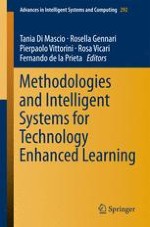2014 | Buch
Methodologies and Intelligent Systems for Technology Enhanced Learning
herausgegeben von: Tania Di Mascio, Rosella Gennari, Pierpaolo Vitorini, Rosa Vicari, Fernando de la Prieta
Verlag: Springer International Publishing
Buchreihe : Advances in Intelligent Systems and Computing
